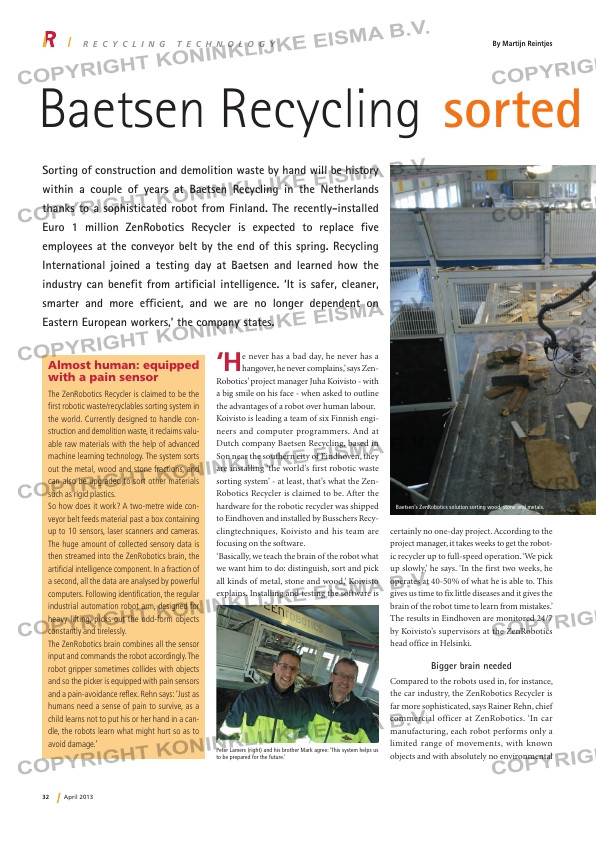Page 32 from: April 2013

32 April 2013
Baetsen Recycling
‘He never has a bad day, he never has a hangover, he never complains,’ says Zen-
Robotics’ project manager Juha Koivisto – with
a big smile on his face – when asked to outline
the advantages of a robot over human labour.
Koivisto is leading a team of six Finnish engi-
neers and computer programmers. And at
Dutch company Baetsen Recycling, based in
Son near the southern city of Eindhoven, they
are installing ‘the world’s first robotic waste
sorting system’ – at least, that’s what the Zen-
Robotics Recycler is claimed to be. After the
hardware for the robotic recycler was shipped
to Eindhoven and installed by Busschers Recy-
clingtechniques, Koivisto and his team are
focusing on the software.
‘Basically, we teach the brain of the robot what
we want him to do: distinguish, sort and pick
all kinds of metal, stone and wood,’ Koivisto
explains. Installing and testing the software is
certainly no one-day project. According to the
project manager, it takes weeks to get the robot-
ic recycler up to full-speed operation. ‘We pick
up slowly,’ he says. ‘In the first two weeks, he
operates at 40-50% of what he is able to. This
gives us time to fix little diseases and it gives the
brain of the robot time to learn from mistakes.’
The results in Eindhoven are monitored 24/7
by Koivisto’s supervisors at the ZenRobotics
head office in Helsinki.
Bigger brain needed
Compared to the robots used in, for instance,
the car industry, the ZenRobotics Recycler is
far more sophisticated, says Rainer Rehn, chief
commercial officer at ZenRobotics. ‘In car
manufacturing, each robot performs only a
limited range of movements, with known
objects and with absolutely no environmental
R e c y c l i n g t e c h n o l o g y By Martijn Reintjes
Almost human: equipped
with a pain sensor
The ZenRobotics Recycler is claimed to be the
first robotic waste/recyclables sorting system in
the world. Currently designed to handle con-
struction and demolition waste, it reclaims valu-
able raw materials with the help of advanced
machine learning technology. The system sorts
out the metal, wood and stone fractions, and
can also be upgraded to sort other materials
such as rigid plastics.
So how does it work? A two-metre wide con-
veyor belt feeds material past a box containing
up to 10 sensors, laser scanners and cameras.
The huge amount of collected sensory data is
then streamed into the ZenRobotics brain, the
artificial intelligence component. In a fraction of
a second, all the data are analysed by powerful
computers. Following identification, the regular
industrial automation robot arm, designed for
heavy lifting, picks out the odd-form objects
constantly and tirelessly.
The ZenRobotics brain combines all the sensor
input and commands the robot accordingly. The
robot gripper sometimes collides with objects
and so the picker is equipped with pain sensors
and a pain-avoidance reflex. Rehn says: ‘Just as
humans need a sense of pain to survive, as a
child learns not to put his or her hand in a can-
dle, the robots learn what might hurt so as to
avoid damage.’
Sorting of construction and demolition waste by hand will be history
within a couple of years at Baetsen Recycling in the Netherlands
thanks to a sophisticated robot from Finland. The recently-installed
Euro 1 million ZenRobotics Recycler is expected to replace five
employees at the conveyor belt by the end of this spring. Recycling
International joined a testing day at Baetsen and learned how the
industry can benefit from artificial intelligence. ‘It is safer, cleaner,
smarter and more efficient, and we are no longer dependent on
Eastern European workers,’ the company states.
sorted by artificial intelligence
Peter Lamers (right) and his brother Mark agree: ‘This system helps us
to be prepared for the future.’
Baetsen’s ZenRobotics solution sorting wood, stone and metals.
RI-3_ZenRobotics Baetsen.indd 32 08-04-13 09:16



